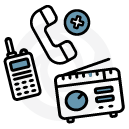Hurricane Season 2022:
Make sure your site is ready
Emergency Readiness is our business, so we find that our customers and everyone in our industry are amazingly resilient. We often hear from them, “prepare for the worst; hope for the best.”
Hurricane Season officially started on June 1, and the NOAA has predicted a more active season than usual. With recent challenges in mind, inFRONT asked for some insight from a long-time AllClear user. Cheri Ardoin is the Emergency Response Coordinator at the Westlake South Chemical plant in Westlake, Louisiana. In the 12 months starting from February 2020, her site experienced four major natural disasters (all weather-related) and two major incidents. Cheri was kind enough to share some of her lessons in the form of a “Hurricane Readiness” checklist of tasks and supplies that are the lessons learned from some challenging situations. We hope it serves you and your site well.
“We have had a few natural disasters in which we thought that it would pass and we would have resources in a few days, but instead, we were out of power and resources for 2-3 weeks. This included food, water, fuel, cell phones, and necessities. Plan for this.”
– Cheri Ardoin, Emergency Response Coordinator at the Westlake South Chemical Plant in Westlake, Louisiana
Before the Storm:

- Lock inbound gates and start an AllClear Event for Accountability on-site. Print out a paper copy of all accounted for in case of power failure.
- Have a large fuel source on-site and a delivery method/schedule/list set up to dispense this fuel to everything that will need it (generators, etc.).
- Obtain a list of Shelter In Place locations for all employees.
- Email inFRONT’s support team and let them know that you are riding out a storm. They will stay on standby and help when requested.
- Have any type of environmental monitors on-site, be trained to use them, and have backup batteries or power sources to charge them. Do not rely on contractor companies that may not be able to get to you for a long time.
- Have enough SCBAs and spare bottles on hand for a release.
- Move all needed vehicles (especially emergency vehicles) and equipment to “bomb-proof” shelters. Wind can blow out your vehicle’s windows, and rain can damage electrical systems, leaving you without vehicles afterward.
- Block in and drain unneeded lines, including fire water lines. Lines may break apart during the storm, and you will not have a way to block them in without putting lives in danger.
- Fill tanks up, so they don’t blow off of their footings.

- Initiate and test your communication system call for Shelter In Place. This can be plant speakers or an all-call radio channel. Do not rely on cell phones in case cell towers are down.
- Have backup batteries for radios, flashlights, environmental meters, and other critical electronics.
- Have a fuel-powered source to charge backup batteries and use as power sources (welding machines, light plants, generators, etc.). The more, the better. Have large and small sources.
- Evaluate information from the weather channel.
- Have portable wifi devices.
- Have a phone line with prerecorded messages for employees calling to find out what to do or when to come to work.
- If it is critical to have people in the facility, make sure you have operations, maintenance, and emergency response (including medically trained) on-site. Others may not be able to get back into the facility for an extended period.
Have multiple weeks’ worth of these supplies and put some at ride-out locations before the storm:
- Nonperishable foods and drinks
- Toiletries
- Bedding
- PPE @ ride out locations
- Flashlights
- Batteries of all sizes
- Fans
- Long extension cords to run power off of light plants for living quarters
- Rope
- Extra clothing, socks, underwear, etc
- Portable shower, toilet trailers, and full water holding tanks
After the Storm has Passed:

- Perform accountability and compare to the earlier report.
- Send the safety team out first to evaluate before permitting any others to leave shelters.
- AllClear can be a way of keeping up with payroll time for those “ride-out” personnel.
- Portable AllClear stations can be used at gates to keep up with traffic in and out of the facility.
- Hook up portable power supplies to your accountability stations in case of other secondary emergencies and put them on the fuel list.

- Start another AllClear event for the clean-up stage.
- Get water to safety showers and fire water back on.
- Have personnel (like guards) on-site to help deliver food, block roads, and help perform accountability at gates.
